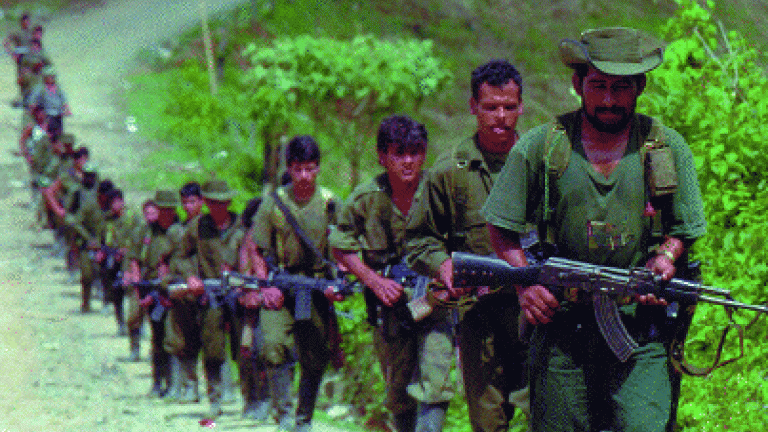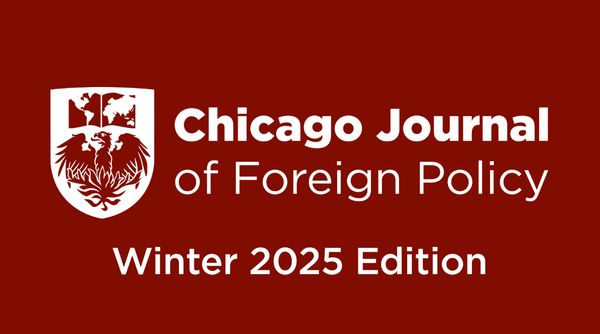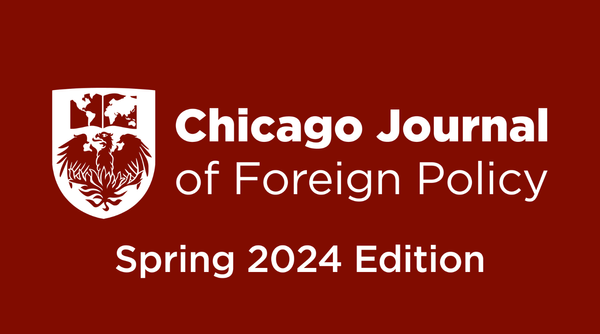Sanctions and Militant Violence

Image available at: https://cisac.fsi.stanford.edu/mappingmilitants/profiles/revolutionary-armed-forces-colombia-farc
By Treyton Zanutto- Texas A&M ’22
- Introduction
Sanctions are an important and increasingly common part of the modern globalized world. The importance of sanctions has become more evident as the western world has responded to the present Russian invasion of Ukraine with the large-scale implementation of sanctions. However, as these sanctions become ever more critical to achieving foreign policy goals, it is essential to know how effective they are when used in differing scenarios.
One of the most frequent scenarios is the use of targeted international sanction regimes in an effort to reduce violence originating from militant groups. Some of the most prolific users of such sanctions are the United States (US), European Union (EU), and United Nations (UN). Despite the widespread adoption of the tactic, questions regarding the effectiveness of targeted international sanctions regimes remain. The question at hand is, “Do targeted international sanctions reduce militant violence?” States may, and often do, have other policy objectives instituting sanctions. Violence reduction is nearly always among the most important, despite the vast array of foreign policy goals, when placing sanctions on militant groups. For this purpose, finding whether the total deaths resulting from militant violence are reduced when international sanctions are applied is vital to determining if targeted international sanctions are an effective tactic to mitigate militant violence. Militant groups will be considered a collection of multiple people who are organized, named, and have displayed an active willingness to utilize armed force.
In this paper, I argue that targeted international sanction regimes used by the US, UN, and EU are often ineffective at reducing militant violence across the globe. This ineffectiveness is because they are not always enforced by all various international powers and are circumvented by militant groups. I test the argument by examining the cases of Bosnia-Herzegovina, Colombia, and the Ivory Coast. The examination of these three cases reveals a trend of deaths from militant violence increasing in the years following the implementation of a targeted sanction regime.
I will briefly examine previous works on sanctions efficacy, present my argument, and then examine three cases to elucidate how sanctions may impact militant violence in conflicts worldwide.
- Previous Research
When researching the effectiveness of UN targeted sanctions, Biersteker et al. found that the targets used evasion and coping techniques in over 90% of cases. The ability to avoid international targeted sanctions significantly restricts their potential effectiveness. The same study found that UN targeted sanctions were only effective at constraining target behavior 27% of the time and coercing a change in behavior 10% of the time. There is little reason to believe that other targeted sanction regimes would see any greater success. The datasets cited above consider targeted sanctions in general and not those placed explicitly on militant groups. Still, the data portrays a general trend that does not bode well for targeted sanction regimes. Suppose targeted sanctions are being evaded frequently and are proving to be ineffective. In that case, the claim that such sanctions significantly reduce the ability of militant groups to finance their operations is called into question.
The literature does not give concrete answers as to what specific impact targeted sanctions have on militant violence. A greater focus on militant groups is required as deaths from militant violence have reached record highs, with the years leading up to 2020 having the greatest levels of non-state violence ever recorded by the Uppsala Conflict Data Program (UCDP).
- Legal Landscape
The League of Nations first utilized the widespread use of an organized international sanctions regime, then continued by the modern UN. Sanctions were “expected to act as a deterrent while imposition would bring conformity.” In theory, international sanctions are a policy tool yielded by an authoritative body much in the same way that a state may use force against its citizens to compel obedience to its laws. Today “the Security Council has the authority to order sanctions to meet a threat or a breach of the peace or in response to an act of aggression, and members are bound to carry out its decisions.” The supranational authority of the UN and the governing body of the Security Council give international sanctions legal legitimacy. The UN provides a framework that all states, at least in theory, tacitly provide consent. The UN then determines and enforces international norms.
However, the legal framework described above has natural limitations, challenges, and exceptions. One of these challenges is that states tend to view themselves as an exception to the authority of the UN to impose sanctions. Most states reserve the right to place sanctions independently as they see fit and view sanctions as a violation of sovereignty when placed upon them. In this regard, the US is particularly notorious as “it has implemented a great variety of measures unilaterally.” The US, and to a lesser extent the EU, are known for instituting international sanctions alongside their allies regardless of the UN Security Council’s wishes. The willingness of states to create widespread sanction regimes independently weakens the theoretical framework for how a sound legal landscape of international sanctions ought to function. However, the concept of international norms and the expectation of moral justification remains even if the Security Council does not approve a specific sanction.
The legal landscape of modern global sanction regimes is one of ordered anarchy. For the most part, states are free to take any action they wish regarding how they enact various sanctions. In practice, the theoretical framework of an ordered international body successfully supports the idea of norms by convincing states that they require a justification to act outside of the international community. States risk their prestige and diplomatic relations when operating outside supranational bodies like the UN. These factors lead to the legal landscape of modern global sanctions regimes being made of bendable rules that international actors twist beyond recognition but rarely outright break.
- Argument
The legal landscape’s flexible nature results in international sanctions often falling short of their goals. International sanctions may falter when they are placed to reduce violence from militant groups and not to compel other states’ obedience. The reasons for international sanctions against militant groups faltering vary, but the most prominent is their inconsistent application between international powers and the ability of militant groups to acquire alternative resources to continue their campaigns.
Proponents of using international sanctions regimes will argue that such sanctions prevent terrorists from acquiring resources and create a stigma around associating with particular groups. Militantism is not cheap, and any barrier to entry makes conducting attacks more difficult. Proponents of international sanctions point out that “Beyond the direct material costs of an attack, which can be thousands of dollars, there are longer-term expenses such as monthly payments to the family of the ‘martyr.'” This example provided by Phillips (2019) is specific to an argument supporting the Foreign Terrorist Organization (FTO) list, but the FTO list is a form of a targeted sanction regime, and the argument can be extrapolated out to other sanction regimes more generally. The argument postulates that the international community can hinder a militant group’s ability to provide compensation for its members or finance its operations by sanctioning said group.
However, restricting a militant group’s ability to conduct various activities requires the targeted sanctions to be effective. If militant groups can compensate for sanctions somehow, the sanctions’ restricting effects would be nullified. One hardly expects militant groups to be unwilling to engage in secretive, illicit, or unexpected occupations to gain income. A sanctioned militant group may loot, sell illegal goods, or smuggle to profit. It would be difficult for international sanctions to restrict obscure markets, especially when the target is determined and willing to take extreme measures.
Reducing militant violence is a common objective of targeted sanction regimes. If sanctions do disrupt the capability of militant groups to carry out their engagements, then targeted sanctions successfully achieve this foreign policy goal. If militant groups compensate for targeted sanctions and continue carrying out their operations, targeted sanctions have failed in this objective.
Overall, the argument for the utility of international targeted sanctions is logical, and it is tempting to accept it at face value. Unfortunately, evading or coping with targeted sanctions may be more common than most initially suspect. Due to their likely ineffectiveness, the utility of international targeted sanctions regimes against militant organizations is greatly hampered.
- Methodology
By following the real-world impact of targeted sanctions on militant groups, their effectiveness in such situations may be approximated. More specifically, the effectiveness of targeted sanctions will be gauged by observing several examples of sanction regimes against militant groups. The total number of deaths resulting from militant violence will be used as a metric to assess and measure the effectiveness of international sanctions. These examples will be evaluated by comparing the relevant sanctions placed by the UN, EU, or US and the UCDP Conflict Dataset. From 1889 to 2020, many targeted international sanctions were placed on various militant groups across the globe. The UCDP describes itself as “the world’s main provider of data on organized violence and the oldest ongoing data collection project for civil war.” By observing these two resources, it will be possible to determine how targeted sanctions and violence correlate over time.
The cases of Bosnia-Herzegovina, Colombia, and the Ivory Coast were selected based on regional variation, diversity in militant groups, and differences in the scale of the conflicts. Additionally, all the cases have many similarities. These similarities include each militant group consisting of many smaller entities, engaged in conflict with government forces, and subject to targeted sanctions. The cases were selected to portray the effect of international sanctions on militant groups in various circumstances while remaining similar enough to be comparable to one another.
- Case of Bosnia-Herzegovina
First is the case of the Serbian Irregulars within the Republic of Bosnia-Herzegovina. The balkanization of the Federal Republic of Yugoslavia was a messy affair. In the chaos, Bosnia-Herzegovina declared independence, and Bosnia Serbs fought against Bosnia-Herzegovina to secure their own nation-state. In the resulting violence between 1991 and 1995, roughly 12,455 deaths occurred. The pattern of fatalities reveals a pattern of a spike, pause, and then skyrocketing. Deaths spiked to 3,581 between 1991 and 1992. Afterward, deaths decreased by 91.7%, with only 296 deaths in mid-1993. Finally, between mid-1993 and 1995, deaths increased over 28 times to 8,360 deaths.
The Bosnian Serbs were subject to several international sanction regimes. In 1993, the UN Security Council restricted importing and exporting goods through territory controlled by Bosnian Serbs. Likewise, in 1993 the text of Executive Order 12846 included a ban on imports and exports through territory controlled by Bosnian Serbs. Then, in 1994 Executive Order 12934 blocked property and placed other restrictions on areas controlled by Bosnian Serbs. The first two of these sanctions were enacted in the least deadly portion of the conflict. Shortly afterward, deaths began to increase, and the third sanction, Executive Order 12934, was put in place. In less than a year following the enactment of these sanctions, the death count went from one of its lowest points to being over double the previous high.
It is essential to look at the context in which they were implemented and the confounding factors that may have impacted the situation to understand why these sanctions may have failed. The UN involved itself in Bosnia-Herzegovina, most likely for the reasons articulated in the UN Security Council Resolution 820; the UN was “Deeply alarmed and concerned about the magnitude of the plight of innocent victims of the conflict in the Republic of Bosnia and Herzegovina.” The UN realized that it alone did not have the resources to control the situation and appealed to regional organizations like the US and EU. The US agreed to North Atlantic Treaty Organization (NATO) participation primarily out of a need to redefine the alliance’s purpose after the Soviet Union collapsed. The EU likely agreed to participate out of concern for the potential of instability in former Yugoslavia spreading further throughout Europe. In 1992, NATO began carrying out and assisting with UN peacekeeping operations. Then in 1993, NATO started to enforce UN resolutions by implementing blockades, no-fly zones, and secure zones. As shown in Figure 1, deaths resulting from Serbian Irregular violence were already declining towards one of the lowest points throughout the conflict when UN and NATO forces involved themselves in 1992.
However, in 1993 Bosnian Croats joined the fight and revitalized the conflict leading deaths to climb to their highest point in 1994, preceding the Dayton Peace Accords and Erdut agreement in 1995. It is unclear if the increase in violence in 1994 is due to the implementation of sanctions or if the reduction of violence is only reflective of the time it took militant forces to adapt to the UN and NATO presence. While it is not clear if the sanctions caused the increased violence, it is clear that they did not prevent the increase in violence from occurring. There is little reason to believe that the sanctions are responsible for the brief period of reduced violence.
In the case of Bosnia-Herzegovina, the targeted sanctions regime placed against the Bosnian Serbs failed horrendously. They were unable to permanently reduce militant violence and allowed for such violence to increase dramatically. The sanctions, in this case, were ineffective following the entrance of another group into the conflict. International sanctions did not reduce the ability of the Bosnian Serbs, reinvigorated by the entry of the Bosnian Croats into the conflict, to cause heightened deaths. The violence was only able to end with the negotiating and signing of the Dayton Accords in 1995.
- Case of Colombia
The second example of targeted sanctions in action is the case of the Revolutionary Armed Forces of Colombia (FARC). FARC consisted of rural rebels with strong communist sympathies who fought the ruling government of Colombia and turned to the illegal drug trade to finance their operations. There were roughly 22,093 deaths throughout the conflict, but notably, only about 4,091 of those deaths resulted from non-state violence. As shown in Figure 2b, casualties from FARC violence were relatively low from 1989 to 1997 and from 2006 onward but significantly higher between 1997 and 2006. The height of casualties was from mid-2000 to 2001, with about 933 deaths. FARC was targeted by international sanctions in 1997 when the US placed the group on its FTO list. Later, FARC was sanctioned by the EU in 2011 through Council Implementing Regulation No. 83/2011. The results of the sanctions, in this case, seem to be a mixed bag. Immediately following the US sanctions, FARC violence increased roughly 433%. Still, the EU sanctions took place after the violence had already declined over 97% from its height, and afterward, the violence continued to decline slowly. Again, these sanctions appear ineffective as the US sanctions still allowed the rampant increase of violence. The EU sanctions seem to have only targeted an already rapidly diminishing conflict.
Throughout the conflict, the Colombian government was responsible for most casualties. A significant portion of these casualties were a result of Plan Colombia. Plan Colombia was a plan announced in 1999 that was meant to revitalize the Colombian economy and combat the illegal drug trade with the support of the US. Before Plan Colombia, the US was assisting with the Colombian government’s anti-drug operations, with the US providing $64 million worth of military supplies to the effort in 1989. However, Plan Colombia was a much larger operation, with the US committing $6.1 billion to the effort from 2000 to 2008. The effectiveness of Plan Colombia is unclear. The height of militant violence followed the implementation of Plan Colombia, but the use of militant violence was also reduced to its lowest point near the conclusion of plan Colombia. It is possible that the implementation of Plan Colombia assisted the sanctions, but, as shown in Figure 2b, the highest instances of deaths from FARC violence occurred shortly after the implementation of Plan Colombia, with 698 deaths from non-state violence from the year 1999 to 2000 and 993 deaths from the year 2000 to 2001. While the violence would eventually subside, the scale of the violence following the implementation of the US sanction regime and Plan Colombia calls into question the effectiveness of both the plan and international sanctions.
While sanctions do not seem to have resulted in the desired decline of violence, the violence eventually declined. This decline may owe more to Plan Colombia than is evident at first glance. Recent research by Sally Sharif finds that while state attacks reduced the trust amongst FARC members needed to make peace, such attacks also eliminated enough FARC leadership to render them irreplaceable, thus suffocating operational capabilities. With this research in mind, it appears that not sanctions but sheer attrition eventually reduced deaths resulting from FARC violence.
- Case of the Ivory Coast
In the Ivory Coast case, the militant rebel groups are collectively known as the Forces Nouvelles, and President Koudou Laurent Gbagbo led the government. The US, EU, and UN each individually sanctioned the government leadership, but all sanctions on the Forces Nouvelles were implemented through the UN Security Council. Western powers seemed to have little interest in getting involved in the civil war apart from protecting international interests and civil society. However, as Glulia (2012) put it, “Gbagbo’s stubborn resistance after the entry of the FRCI in Abidjan has had the consequence of pushing UN and French peacekeepers into intervening…”. Ultimately, the extreme anti-western stance of the Gbagbo regime and the lack of respect for democratic processes would lead Western powers to prefer his removal from power. However, the extreme violence from rebel groups would still result in them being sanctioned by the international community.
The civil war in the Ivory Coast resulted in many deaths from all sides of the conflict. From 1989 to 2020, there were 3,599 deaths. However, many did not result from non-state violence. As shown in Figure 3b, the violence reached one of its highest points between 2001 and 2006 but was relatively minor in scope for most other years, with the notable exception of 2010 to 2011. In addition to a general arms embargo on the Ivory Coast as a whole, sanctions were placed on the Forces Nouvelles and others perceived to be slowing the peace process from 2004 to 2016 by UN Security Council Resolution 1572. The violence from militant groups in the Ivory Coast decreased in the wake of these sanctions. However, the violence appears to have already been declining before implementing the sanctions, with deaths from Forces Nouvelles violence having decreased roughly 60.6% since the previous high around the time the sanctions were implemented. These sanctions did not result in the same degree of failure as the sanctions in the previous case studies, but their results were not stellar. As seen in Figure 1 and Figure 3b, the difference between the result of international sanctions can be observed in the Bosnia-Herzegovina case and the case of the Ivory Coast. In Bosnia-Herzegovina, deaths from Serbian Irregulars increased by roughly 28-fold in the wake of sanctions. On the other hand, deaths increased by approximately 7.5 times in the Ivory Coast and had a general decreasing trend after 2011. However, whether or not the failure was due to chance is unclear.
Between 2002 and 2011, the Ivory Coast experienced two civil wars and an electoral crisis, all surrounding the leadership of Mr. Gbagbo. The international community spent eight years conducting peacemaking operations before launching the UN Operation in Côte d’Ivoire (UNOCI) and the French peacekeeping mission Licorne which assisted in ousting the Gbagbo regime. It appears that as international intervention against Mr. Gbagbo’s forces increased, violence from the Forces Nouvelles decreased. The decrease in violence from the Forces Nouvelles may be due to international forces taking independent action against the Gbagbo government, thus reducing the necessity of the Forces Nouvelles to conduct fighting themselves.
- Conclusion
While the increase in militant violence after the implementation of international sanctions may be due to factors besides the sanctions themselves, it does show a concerning failure to prevent or reduce violence. Only in the case of the Ivory Coast did violence from militant groups decrease after the implementation of sanctions, but this appears to have been due to the international community becoming militarily involved. Targeted international sanction regimes appear to be roundly ineffective as they have repeatedly failed to reduce deaths from militant violence.
This reality is troublesome and raises more questions than it answers. The ineffectiveness of targeted sanctions in reducing militant violence shows that the international communities’ current method of dealing with militant groups needs self-reflection. These failures do not mean that there is no place for targeted sanctions. As a recent article by Justyna Gudsowska and John Prendergast points out that targeted sanctions can be effective against international corruption by “adjusting and calibrating actions against an entire corrupt network over an extended period of time and with a clear objective.” Further research into the subject is required to prevent unnecessary deaths. More research is necessary to determine to what degree targeted sanctions are ineffective against militant groups and determine if there are any benefits to their use. However, as targeted sanctions are currently implemented against militant groups, they appear to be easily avoided or compensated for, rendering them often ineffective and perhaps even harmful.
Citations
Biehler, Gernot “Legal Limits to International Sanctions,” Hibernian Law Journal 4 (2003): 15-24
Biersteker, Thomas J., Sue E. Eckert, and Marcos Tourinho, eds. “Targeted Sanctions: The Impacts and Effectiveness of United Nations Action.” Cambridge: Cambridge University Press, 2016. doi:10.1017/CBO9781316460290.
Clinton, William J. “Additional Measures With Respect to the Federal Republic of Yugoslavia.” Archives.gov. US Treasury Department, 1993. https://www.archives.gov/files/federal-register/executive-orders/pdf/12846.pdf.
Clinton, William J. “Blocking Property and Additional Measures With Respect to the Bosnian Serb-Controlled Areas of the Republic of Bosnia and Herzegovina.” Archives.gov. US Treasury Department, 1994. https://www.archives.gov/files/federal-register/executive-orders/pdf/12934.pdf.
“COUNCIL IMPLEMENTING REGULATION (EU.) No 83/2011.” EUR. Official Journal of the EU, 2011. https://eur-lex.europa.eu/legal-content/EN/TXT/?uri=CELEX%3A32011R0083.
Doxey, Margaret “International Sanctions in Theory and Practice,” Case Western Reserve Journal of International Law 15, no. 2 (Spring 1983): 273-288
“Foreign Terrorist Organizations – United States Department of State.” U.S. Department of State. U.S. Department of State, December 4, 2021. https://www.state.gov/foreign-terrorist-organizations/.
Gudzowska, Justyna, and John Prendergast. “Can Sanctions Be Smart? The Costs and Benefits of Economic Coercion.” Foreign Affairs, March 1, 2022. https://search.ebscohost.com/login.aspx?direct=true&db=edsinc&AN=edsinc.A694983401&authtype=shib&site=eds-live&scope=site.
Leurdijk, Dick A. “Before and after Dayton: The UN and NATO in the Former Yugoslavia.” Third World Quarterly 18, no. 3 (January 1, 1997): 457–70. https://search.ebscohost.com/login.aspx?direct=true&db=edsjsr&AN=edsjsr.3993263&site=eds-live.
McAllister, Jacqueline R. “Deterring Wartime Atrocities: Hard Lessons from the Yugoslav Tribunal.” International Security 44, no. 3 (Winter2019/2020 2019): 84–128. doi:10.1162/isec_a_00370.
Oehme, Chester G. (2010) Plan Colombia: Reassessing the Strategic Framework, Democracy and Security, 6:3, 221-236, DOI: 10.1080/17419166.2010.521055
Pettersson, Therése, Shawn Davies, Amber Deniz, Garoun Engström, Nanar Hawach, Stina Högbladh, and Margareta Sollenberg Magnus Öberg. “Organized Violence 1989–2020, with a Special Emphasis on Syria.” Journal of Peace Research 58, no. 4 (July 2021): 809–25. https://doi.org/10.1177/00223433211026126.
Phillips, Brian J. “Foreign Terrorist Organization Designation, International Cooperation, and Terrorism.” International Interactions 45, no. 2 (March 2019): 316–43. doi:10.1080/03050629.2019.1556158.
Piccolino, Glulia “David against Goliath in Côte D’Ivoire? Laurent Gbagbo’s War against Global Governance.” African Affairs, 111(442), 23, 2012, https://doi.org/10.1093/afraf/adr064
“Resolution 820.” UNSCR. United Nations Security Council, 1993. http://unscr.com/en/resolutions/820.
“Resolution 1572 – The Situation in Côte d’Ivoire.” UNSCR. United Nations Security Council, 2004. http://unscr.com/en/resolutions/1572.
Sharif, Sally (2022) How Wartime Bonds Affect Ex-Combatant Political Attitudes: A Natural Experiment with the FARC, Terrorism and Political Violence, DOI: 10.1080/09546553.2021.2017895
“UCDP.” Department of Peace and Conflict Research. Uppsala Universitet. Accessed January 28, 2022. https://www.pcr.uu.se/research/ucdp/.
“Uppsala Conflict Data Program – FARC.” UCDP. Uppsala Universitet. Accessed January 28, 2022. https://ucdp.uu.se/actor/743.
“Uppsala Conflict Data Program – Ivory Coast.” UCDP. Uppsala Universitet. Accessed January 28, 2022. https://ucdp.uu.se/country/437. “Uppsala Conflict Data Program.” UCDP. Uppsala Universitet. Accessed January 28, 2022. https://ucdp.uu.se/actor/3864.





